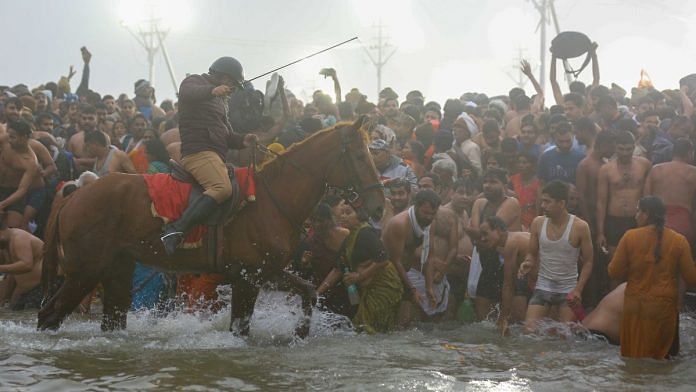Thank you dear subscribers, we are overwhelmed with your response.
Your Turn is a unique section from ThePrint featuring points of view from its subscribers. If you are a subscriber, have a point of view, please send it to us. If not, do subscribe here: https://theprint.in/subscribe/
The Maha Kumbh Mela, a monumental Hindu pilgrimage, is currently underway in Prayagraj, Uttar Pradesh, from January 13 to February 26, 2025. The Maha Kumbh Mela 2025 stands as a testament to India’s rich spiritual heritage and the enduring faith of millions.
The Kumbh Mela commemorates the mythological battle between gods and demons over a pot of nectar. The festival symbolizes the victory of good over evil and is a time for spiritual renewal. Devotees believe that bathing in the confluence of the Ganges, Yamuna, and the mythical Saraswati rivers at Prayagraj cleanses sins and leads to liberation.
The festival has also seen a resurgence of ancient Hindu akhara sects, with over 10,000 new sadhus initiated. This revival is linked to the support from the current government, which advocates for a Hindu state. The event has become a platform for these sects to gain prominence and influence.
Unprecedented Participation
This year’s Maha Kumbh Mela has witnessed an extraordinary turnout, with over 500 million people participating in the holy dip over the past four weeks. To accommodate the massive influx of devotees, the Uttar Pradesh government has established a temporary city covering 4,000 hectares. This includes 150,000 tents, 12 kilometers of ghats, and enhanced transportation facilities. Special trains and increased road networks have been implemented to manage the large crowds.
This event, held once every 12 years, is positioned as a Maha Kumbh, occurring once in 144 years. Maha Kumbh Mela 2025 has sparked a significant fear of missing out (FOMO) syndrome among Hindus worldwide. This is because of the Once-in-a-Lifetime Event – The Maha Kumbh Mela happens only once every 144 years, making it an extremely rare spiritual event. Many of us believe that if they miss this opportunity, they may never witness another Maha Kumbh in their lifetime.
The presence of top Indian leaders, international celebrities, and spiritual figures adds to the prestige of attending. Videos and images of the grand celebrations increase the sense of being left out among those unable to visit.
The grand event has led to a surge in last-minute travel bookings, virtual darshans, and increased religious activities at home for those unable to attend. However, the government and religious organizations are also working to make live streams, online pujas, and spiritual engagements available worldwide to help bridge this gap.
Challenges and Tragedies
Despite meticulous planning, the festival has faced challenges. On January 29, a stampede resulted in the tragic loss of over 30 lives. Additionally, a stampede at a Delhi train station on February 17 led to at least 18 deaths and numerous injuries.
However, some people have started blaming the sheer crowds, population, etc. for the mishaps. Blaming the crowd for tragedies like stampedes is totally unfair. The responsibility lies with government, authorities, and infrastructure planning, not the devotees who come with faith and devotion.
Don’t blame the Crowd, blame the Crowd Management
Pilgrims attend with pure devotion, believing in the spiritual benefits of the Kumbh. Their intention is not chaos but participation in a sacred event. Lack of Proper Crowd Management is the main reason behind the tragedy. With over 500 million visitors, proper traffic control, exit routes, and safety measures should have been in place. The failure to anticipate congestion is an administrative shortcoming, not the pilgrims’ fault.
While authorities expanded facilities, the sheer volume of people required better coordination, trained volunteers, and emergency preparedness. Many tragedies occur because of panic and miscommunication. Authorities should have placed more trained volunteers, signage, and public announcement systems to guide people safely. Past experiences should have guided planners to prevent overcrowding at key points.
Technology like AI-based crowd density tracking, drone surveillance, and emergency alert systems should have been used more effectively to prevent overcrowding hotspots.
Learn from mistakes
Maha Kumbh is a spiritual event that should be safe and joyous for all. Instead of blaming devotees, the focus should be on learning from mistakes and improving future event planning. The faith of millions deserves better protection and respect.
The crowd is not the problem—the lack of effective management is. Millions come with faith, and they deserve a safe, well-organized experience. Authorities should focus on better planning and execution to prevent such tragedies in the future.
These pieces are being published as they have been received – they have not been edited/fact-checked by ThePrint.


